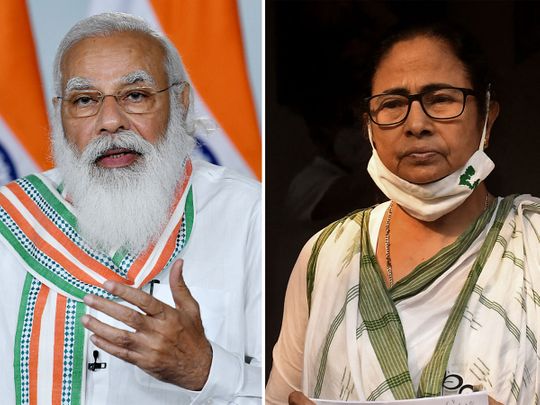
First the spewing of venom over an electoral battle pitch. Then a ‘tu tu-main main’ (‘he said-she said’) over aftermath of cyclone Yaas and finally an ugly tug-of-war over a top civil servant — West Bengal chief secretary Alapon Bandyopadhyay.
The game of political one-upmanship between Indian Prime Minister Narendra Modi and West Bengal Chief Minister Mamata Banerjee was out in the open for long – to be precise, ever since the Bharatiya Janata Party (BJP) emerged as the principal challenger to ruling Trinamool Congress (TMC) in Bengal in the 2014 Lok Sabha elections.
However, the way this catfight of sorts has spilled out into public domain over the last few days is unprecedented not just in the history on Bengal, but in the entire country’s post-independence journey as a federation of states and a multi-party democracy.
For the uninitiated, here’s a bit of background. Earlier this month, the West Bengal Government (read CM Mamata) had requested the federal government for an extension to chief secretary Bandyopadhyay’s tenure, given the crucial role he was playing in formulating and executing the Bengal government’s strategy to counter the COVID-19 pandemic.
He was due to retire from the Central Services on May 31, but the Cabinet Committee for appointment to Central Services on May 24 granted Bandyopadhyay a three-month extension, accepting the Bengal government’s plea.
Mamata’s affront to Modi
However, the script took a rather unsavoury turn from the afternoon of May 28 onwards, when PM Modi reached the Kalaikunda air base in Bengal for a survey of the damages inflicted on the states of West Bengal, Odisha and Jharkhand by cyclone Yaas.
In that meeting, Mamata had reportedly made only a cursory appearance, along with state chief secretary Bandyopadhyay, for just a few minutes – that too after reportedly keeping the PM waiting for about 30 minutes.
In an audacious violation of protocol, neither the Bengal CM nor the state chief secretary were present at the helipad to welcome Modi when he landed. Moreover, the Bengal CM and the chief secretary also skipped the review meeting chaired by Modi in Kalaikunda.
This sequence of events had reportedly peeved the PM and his secretariat to no end. On May 28, the Cabinet Committee for appointments to Central Services suddenly issued a notification to the West Bengal Government, announcing that Bengal chief secretary Bandyopadhyay will have to report at the Department of Personnel and Training in New Delhi at 10am on May 31.
This, according to many political observers, was a retaliatory measure by the Modi-led dispensation at the Centre to counter the Kalaikunda ‘snub’ from Mamata. In a dramatic turn of events thereafter, on the evening May 31, Bandyopadhyay resigned from the Indian Administrative Services (IAS) and was immediately appointed by Mamata as her personal adviser for three years, with effect from June 1.
Aftershocks of a bitter political fight
There is no doubt that what we are noticing in Bengal right now is a precipitation of the politics of vendetta and vitriol that had marked the run-up to the assembly elections, in which the Mamata-led TMC won a third term with an overwhelming majority, crushing all hopes of a BJP ‘takeover’ of Bengal.
This defeat certainly did not go down well with the BJP mandarins in Delhi, particularly Modi and federal Home Minister Amit Shah who led a high-octane, no-holds-barred campaign against Mamata.
Quite naturally, the stakes in these elections were so high that for both, the winners and the losers, the rumblings of a hard-fought political battle are being heard and felt even after the fate of the parties have been decided at the hustings.
That way, what happened at Kalaikunda air base was a sequel to the electoral battle a month ago. But what is indeed unfortunate is the way a top bureaucrat has been dragged into this ‘ping-pong’, in an affront to administrative decorum, thereby threatening the very foundation on which rests Centre-State cohesion and cooperation, which is the cornerstone of India’s federal structure.
Blame lies at Modi-Shah doorstep
And there is no denying the fact that if Mamata’s attitude in dealing with Modi at Kalaikunda air base was not in keeping with constitutional propriety, then the Modi government’s flip-flop with the Bengal chief secretary was a clear sign of administrative jurisprudence being sacrificed at the altar of petty politics.
The lion’s share of the blame in this case rests at the doorstep of Modi and Shah, simply because the Cabinet Committee empowered to rubber-stamp appointments to Central Services, is a two-member body comprising only the PM and the federal home minister.
The decision to first allow the Bengal chief secretary a service extension and then ‘recall’ him rather unceremoniously to Delhi on deputation is a clear indication of how the revered Central Services cadre — that includes IAS and Indian Police Services — can be used as a tool to try and coerce states into compliance and intimidate top bureaucrats and officials into doing the Centre’s bidding at the behest of South Block (read Prime Minister’s Office).
Twitter: @moumiayush








